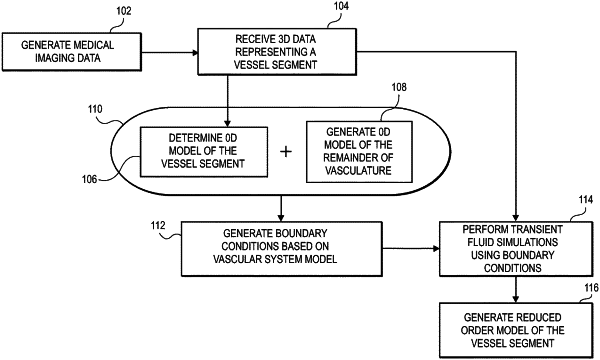| CPC G16H 50/50 (2018.01) [A61B 5/021 (2013.01); A61B 5/02007 (2013.01); A61B 5/0285 (2013.01); A61B 5/7278 (2013.01); A63F 2300/66 (2013.01); G06F 2113/08 (2020.01)] | 24 Claims |

|
1. A non-transitory computer-readable medium storing instructions, which when executed by one or more processors of a system, causes the system to perform a method, comprising:
receiving 3D data representing a vessel segment of a vasculature;
determining a 0D model of the vessel segment based on static fluid simulations of the vessel segment using the 3D data, wherein the 0D model includes a respective inductor and a respective pressure source for each of a plurality of subsegments extending between an inlet and a plurality of outlets of the vessel segment, and wherein values of the pressure sources are taken from a response surface of the static fluid simulations of the vessel segment;
generating a set of boundary conditions of the vessel segment based on a first vascular system model including the 0D model of the vessel segment coupled to a 0D model of a remainder of the vasculature; and
generating a reduced order model of the vessel segment based on transient fluid simulations of the vessel segment using the set of boundary conditions, wherein the reduced order model represents flow in the vessel segment in real-time.
|
|
9. A system, comprising:
a memory to receive 3D data representing a vessel segment of a vasculature; and
one or more processors to
determine a 0D model of the vessel segment based on static fluid simulations of the vessel segment using the 3D data, wherein the 0D model includes a respective inductor and a respective pressure source for each of a plurality of subsegments extending between an inlet and a plurality of outlets of the vessel segment, and wherein values of the pressure sources are taken from a response surface of the static fluid simulations of the vessel segment,
generate a set of boundary conditions of the vessel segment based on a first vascular system model including the 0D model of the vessel segment coupled to a 0D model of a remainder of the vasculature, and
generate a reduced order model of the vessel segment based on transient fluid simulations of the vessel segment using the set of boundary conditions, wherein the reduced order model represents flow in the vessel segment in real-time.
|
|
13. A non-transitory computer-readable medium storing instructions, which when executed by one or more processors of a system, cause the system to perform a method, comprising:
receiving 3D data representing a vessel segment of a vasculature;
determining a 0D model of the vessel segment based on static fluid simulations of the vessel segment using the 3D data, wherein the 0D model includes a respective inductor and a respective pressure source for each of a plurality of subsegments extending between an inlet and a plurality of outlets of the vessel segment, and wherein values of the pressure sources are taken from a response surface of the static fluid simulations of the vessel segment;
receiving measured flow data representing measurements of flow in the vessel segment;
generating simulated flow data representing flow in the vessel segment based on a first vascular system model including a reduced order model of the vessel segment coupled to a 0D model of a remainder of the vasculature, wherein the reduced order model represents flow in the vessel segment in real-time, and wherein the reduced order model is based on the 0D model of the vessel segment; and
adjusting the 0D model of the remainder of the vasculature based on a comparison of the simulated flow data to the measured flow data.
|
|
21. A system, comprising:
a memory to receive 3D data representing a vessel segment of a vasculature and measured flow data representing measurements of flow in the vessel segment; and
one or more processors to
determine a 0D model of the vessel segment based on static fluid simulations of the vessel segment using the 3D data, wherein the 0D model includes a respective inductor and a respective pressure source for each of a plurality of subsegments extending between an inlet and a plurality of outlets of the vessel segment, and wherein values of the pressure sources are taken from a response surface of the static fluid simulations of the vessel segment,
generate simulated flow data representing flow in the vessel segment based on a first vascular system model including a reduced order model of the vessel segment coupled to a 0D model of a remainder of the vasculature, wherein the reduced order model represents flow in the vessel segment in real-time, and wherein the reduced order model is based on the 0D model of the vessel segment, and
adjust the 0D model of the remainder of the vasculature based on a comparison of the simulated flow data to the measured flow data.
|